Of all the frogs available to amphibian enthusiasts, few are as unusual yet endearing as Pacman frogs (Ceratophrys spp.).
Named for their gigantic mouths that are reminiscent of the popular video game character, Pacman frogs are typically hardy, easy-to-maintain animals who often work well for beginning amphibian keepers.
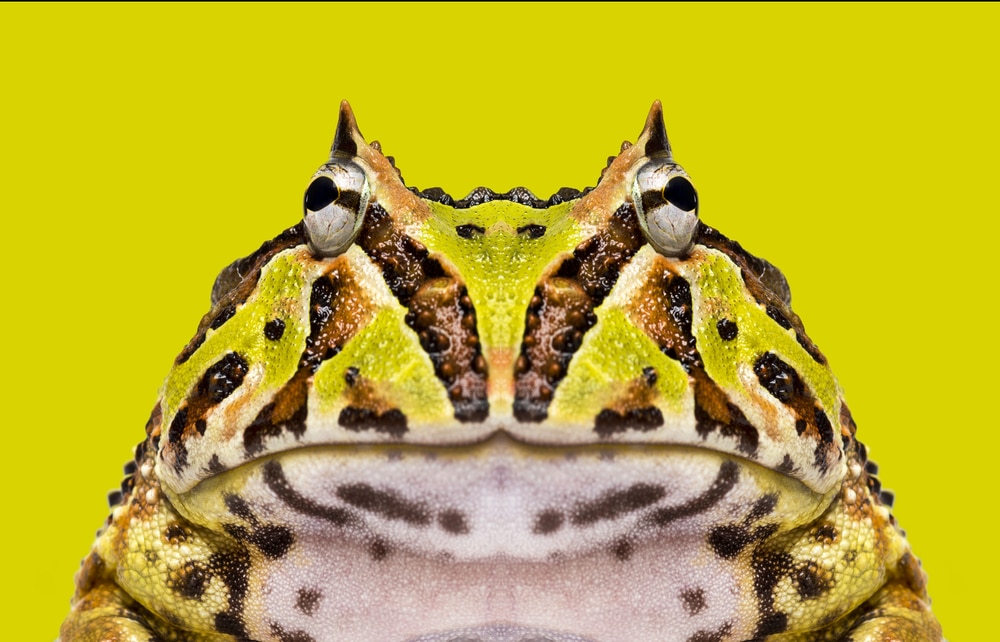
Below, we’ll explain everything you need to know about Pacman frogs, so you’ll be well-prepared for success with your new pet.
Quick Navigation
Defining “Pacman Frogs”: What’s in a Name?
The term “Pacman frog” (or sometimes, Pac-Man frog) is typically applied to several members of the genus Ceratophrys. They’re also frequently called “horned frogs,” thanks to the horn-like projections above their eyes.
Scientists currently recognize eight species within the genus, but the following three are the only ones regularly seen in the pet trade:
- Cranwell’s horned frog (Ceratophrys cranwelli)
- Argentine horned frog (Ceratophrys ornata)
- Surinam horned frog (Ceratophrys cornuta)
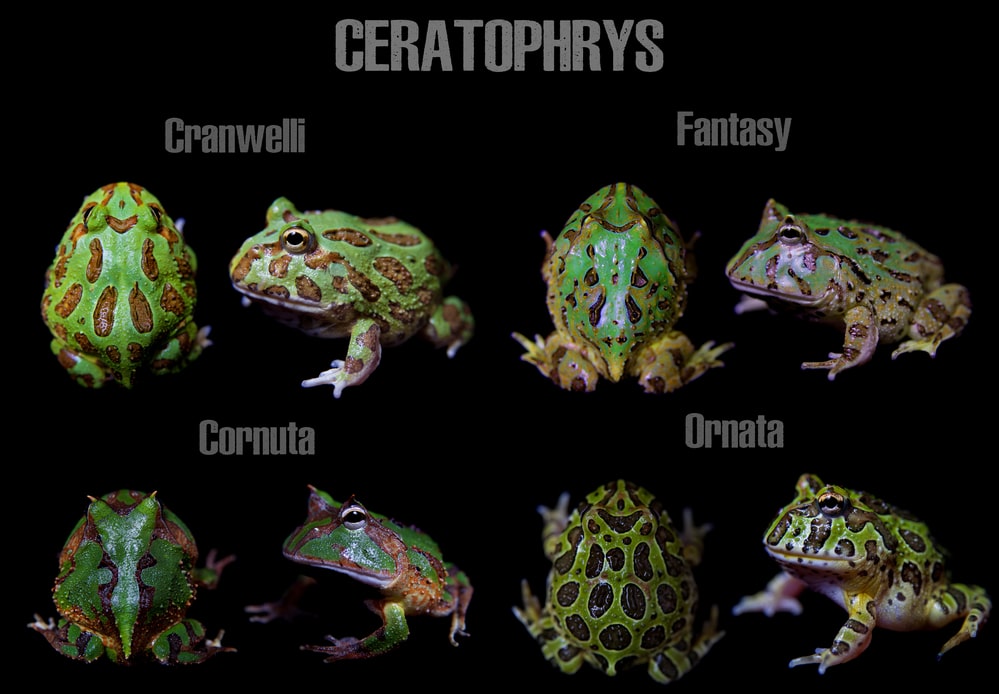
Hybrid individuals are also available for hobbyists interested in keeping a “designer” frog.
All three species vary in terms of color, pattern, and – to a lesser extent – morphology. However, they all engage in similar behavioral patterns, subsist on similar food sources, and require similar husbandry. As far as the beginning hobbyist is concerned, they can all be treated more-or-less interchangeably.
Geographic Range and Habitat of Pacman Frogs
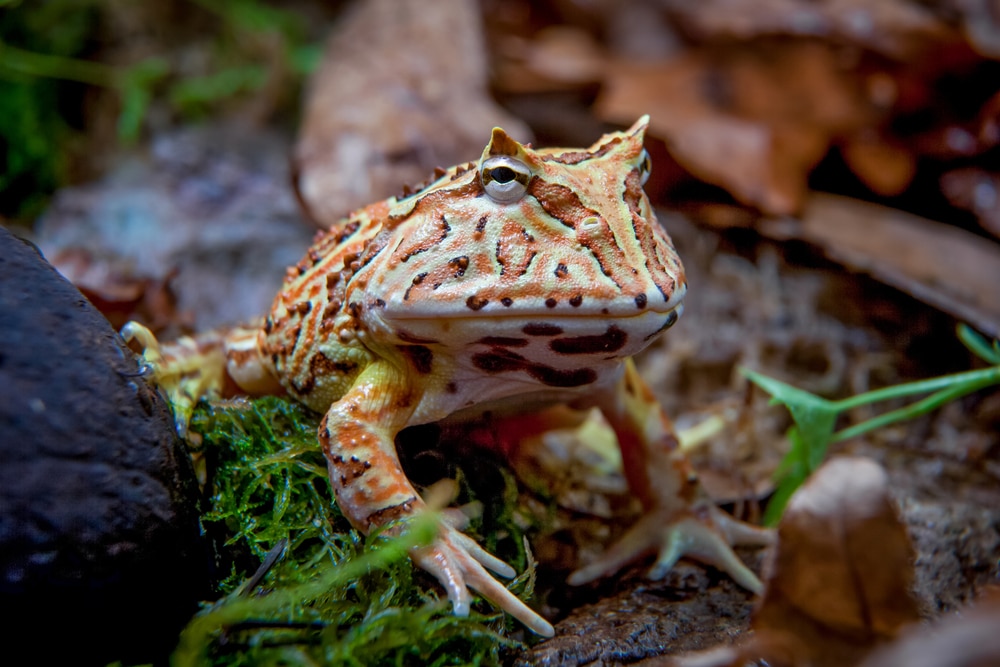
As a group, Pacman frogs range across most of South America, including parts of Ecuador, Venezuela, and Columbia, Bolivia, Paraguay, Uruguay, Brazil and Argentina. The frogs live in a variety of different habitats across this range, but they exhibit a broad preference for hot, damp grasslands with relatively little tree cover.
These frogs may also be found in disturbed areas near human habitation. This includes residential yards, parks and gardens.
The Basic Biology and Natural History of Pacman Frogs
Pacman frogs are relatively inactive frogs, who spend most of their lives half-buried in the substrate. They move around very rarely – typically only to capture food or reach temporary ponds during the breeding season. These frogs will also switch hiding places from time to time.
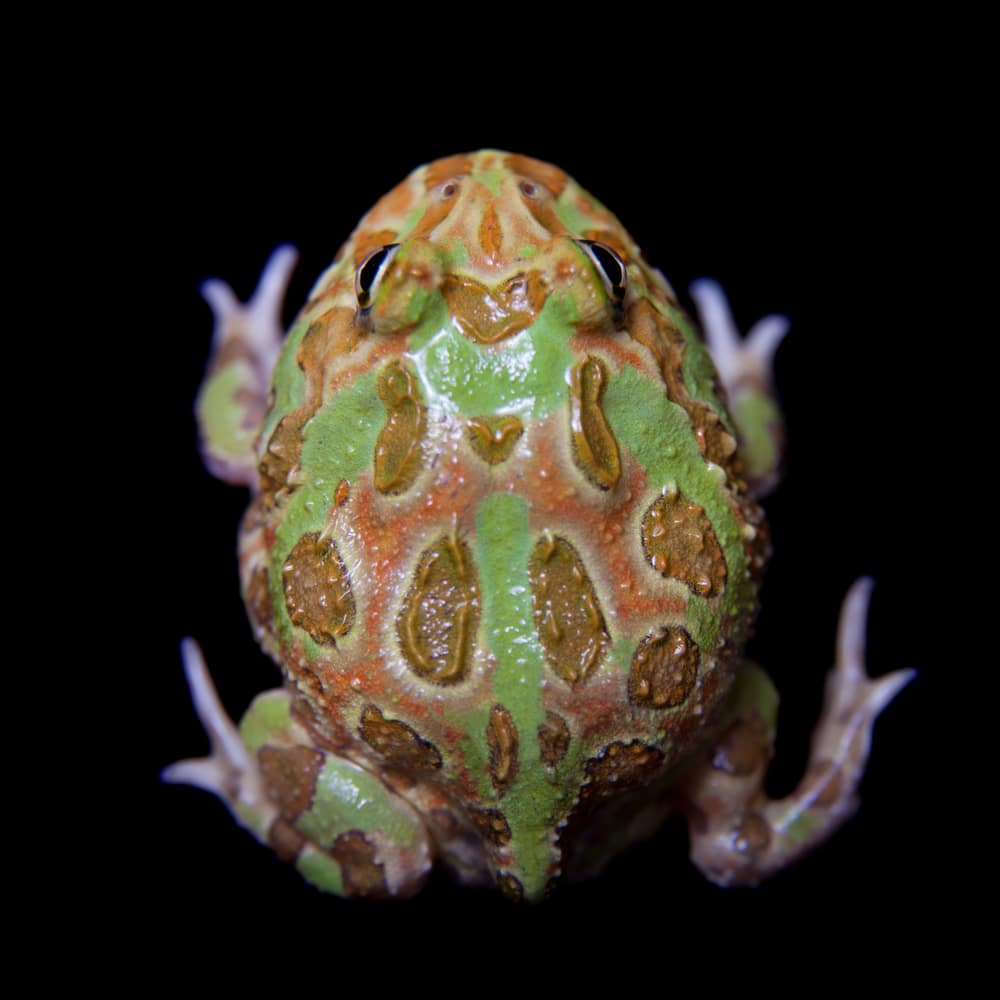
Pacman frogs have voracious appetites, and they are formidable predators for their size.
They’ll typically remain motionless and simply wait for a small animal to walk by.
At this point, they’ll explode into action, grabbing the hapless prey and shoving it into their cavernous mouth. Unlike most other frogs, Pacman frogs have bony, tooth-like projections, which help prevent prey from escaping.
Pacman frogs will consume just about any prey they can capture and overpower. Large insects and arachnids likely make up the bulk of their diet, but these frogs will also consume snakes, lizards, rodents and other frogs.
Female Pacman frogs are pretty prolific breeders, who often deposit up to 2,000 eggs at a time. Because they typically breed and deposit their eggs in temporary pools, Pacman frog tadpoles metamorphosize rather quickly – often in less than two weeks.
During this time, the largest tadpoles in the pond often consume smaller individuals. Their cannibalistic lifestyle may even continue after they grow legs – a fact that keepers are wise to remember when housing these frogs.
Selecting Your Pacman Frog
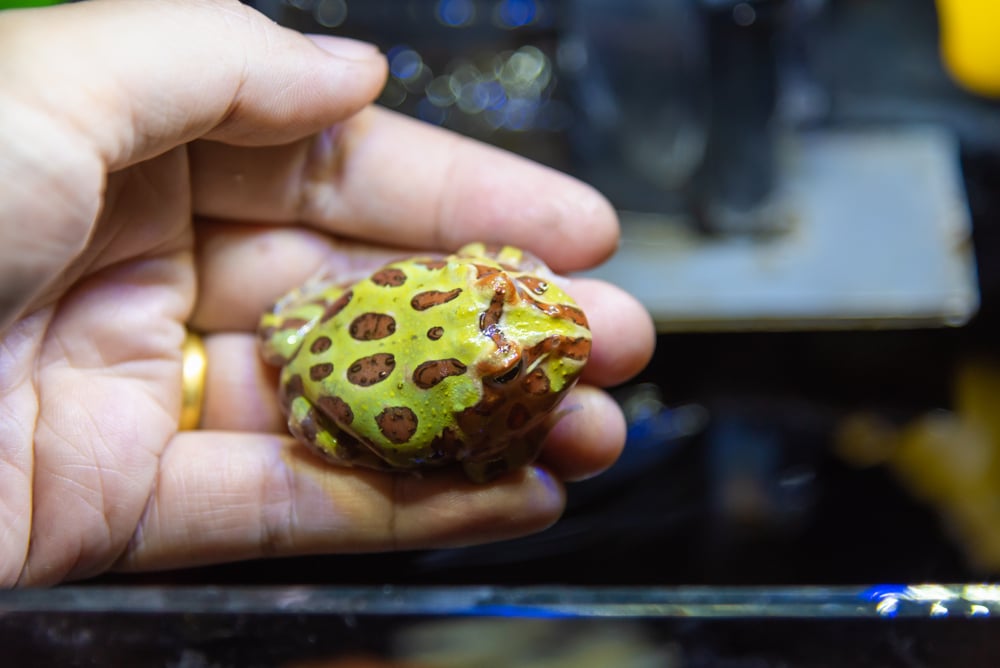
If you’ve decided to pick up a pet Pacman frog, you’ll want to start by selecting a healthy, robust specimen. Don’t select a thin or sickly animal with the hopes of nursing it back to health – this rarely works and incentivizes poor retailer practices.
Look for an individual with a plump body, moist skin and clear eyes. If possible, you may want to request that the seller offer the frog food too. Food refusal doesn’t necessarily mean that the frog is in poor health, but an aggressive reaction to food is typically a good sign.
It doesn’t really matter which Pacman frog species you select, as they all require relatively similar care. Just be sure to select a healthy individual and let your personal aesthetic preferences drive the rest of the selection process.
It is, however, wise for beginning frog keepers to start with a large juvenile, rather than a newly metamorphosized frog.
Frogs that are already at least one month old are much hardier than individuals who’ve only recently reabsorbed their tails and moved to dry ground.
You can start with a full-grown adult if you like, but you’ll need to be comfortable interacting with a potentially pugnacious pet, who probably won’t hesitate to bite if he feels threatened.
Pacman Frog Care: Setting Up and Maintaining the Habitat
Once you’ve selected a Pacman frog and are ready to bring him home, you’ll need to establish a habitat for him. We’ll outline the basic habitat needs for your new Pacman frog below.
Enclosure
Most Pacman frog keepers utilize aquaria, glass cages or plastic storage boxes to maintain their pets. Any of these options will work, but they each exhibit different benefits and drawbacks.
Aquaria and glass cages, for example, provide unparalleled viewing opportunities, but they’re heavy and fragile.
Plastic storage boxes don’t allow you to see your pet very well, but they’re lightweight, affordable and easy to customize.
Regardless of the type of enclosure you select, you’ll want to ensure it is large enough to accommodate your new pet. Pacman frogs are typically very inactive, so they don’t require very large enclosures.
Try to provide your pet with about 1 to 2 square feet of space – roughly the size of a 10- or 20-gallon aquarium.
- [Patent Design] 360 degree view of the terrarrium landscape;
- Full screen top with a feeding hole,which is for ventilation and allows light and UVB penetration;
- "Lift and Pull" for opening and closing the sliding screen top;
Even though Pacman frogs aren’t great climbers or leapers, it is wise to fit the enclosure with a secure lid. This is especially important for those with other pets (particularly cats). A screened lid will work, but it may provide too much ventilation, so you’ll need to partially cover it with a sheet of plastic. If possible, select a solid lid that provides a moderate amount of ventilation holes.
Substrate
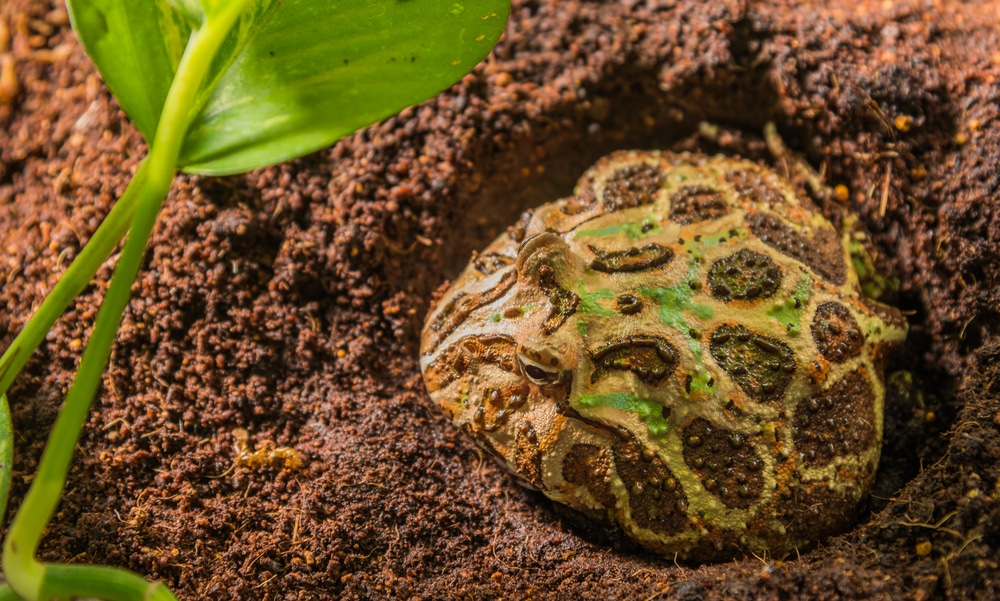
You can use a variety of substrates with your Pacman frog.
Moisture-retaining, particulate substrates that allow the frog to burrow are the best option. This includes things like cypress mulch, orchid bark, coconut husk and soil.
We recommend Zoo Med Eco Earth.
Advanced keepers may have success with sheet-like substrates, but beginners are wise to avoid doing so until they’ve acquired more experience.
Although many keepers use a gravel substrate for their Pacman frog, this is typically not wise. Pacman frogs often end up ingesting a bit of their substrate while feeding, and swallowed rocks can cause intestinal impactions.
No matter which substrate you select, be sure to keep it moderately damp. This will help ensure your dog remains healthy and well hydrated.
Decor & Furniture
It is typically wise to avoid unnecessarily cluttering your Pacman frog’s habitat, but you don’t want to simply provide your frog with a barren habitat, devoid of visual barriers or hiding places.
Instead, try to provide your frog with at least one (and preferably two) hiding place and some live or artificial plants.
By providing your frog with hiding places and including plants in the habitat, he’ll likely feel safer. This will help keep his stress level low, which will help support good overall health.
You can use a variety of things for a hiding place. Small plastic containers with a door cut into the side will work, but you can also use commercially manufactured hide boxes. Corkbark and real wood pieces will also make good hiding places, and they will look relatively natural too.
- PERFECT FOR TERRESTRIAL REPTILES: This hide box is the perfect addition to your terrestrial...
- COST-EFFECTIVE: These hides are the perfect addition to your enclosure at an affordable cost unlike...
- DURABLE: These reptile hide boxes are made of heavy 1/8" thick plastic and can withstand just about...
There are a number of plant species that will work well in a Pacman frog enclosure – just be sure to select a species that thrives in damp, low-light conditions. Golden pothos plants are the default option for many keepers, but feel free to experiment with other non-toxic, hardy species.
Water Reservoir
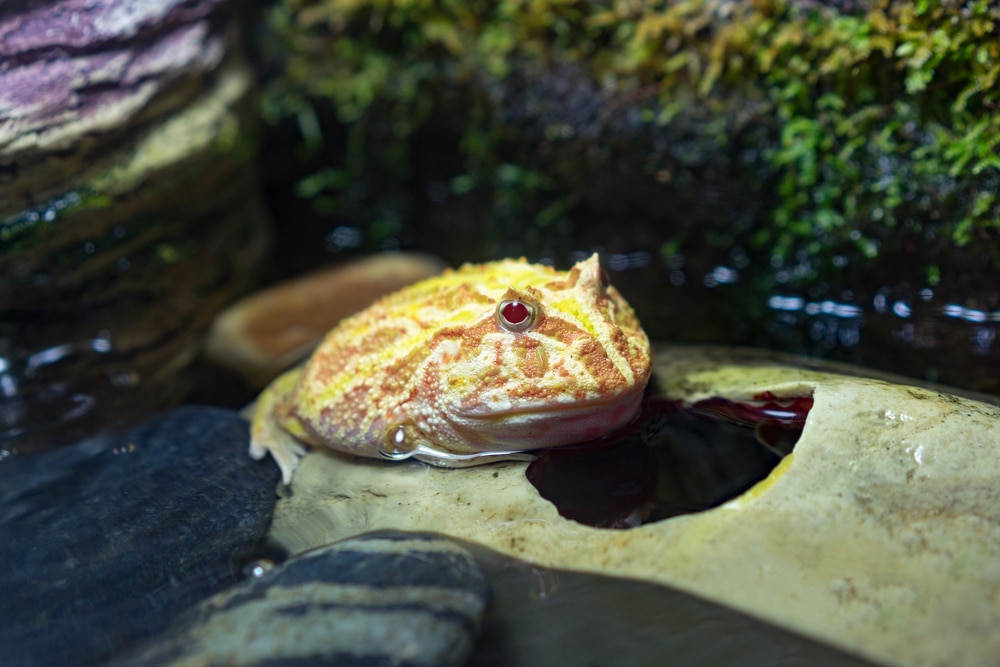
Make sure that you provide your Pacman frog with a large, shallow water dish.
It should be wide enough to accommodate your frog’s entire body, but it should be shallow enough that your frog can rest in the dish while still keeping his nostrils above the surface.
Don’t make your Pacman frog swim, as this may cause him to drown.
- Easy access ramp helps prevent drowning
- Great for lizards, terrestrial land turtles (up to 4/10cm shell length)
- frogs
It is important that you avoid using chlorinated tap water for your frog. Instead, use treated (dechlorinated) tap water or spring water. Do not use distilled water.
Heating and Lighting
The heating and lighting requirements of Pacman frogs are relatively easy to satisfy. In some cases, you won’t need to use lights or heating devices at all.
Pacman frogs will typically thrive with nothing more than the ambient room light entering the enclosure.
They don’t require full-spectrum lighting the way some other species do, and extremely bright lighting may even be stressful for the frogs.
Nevertheless, you can use low-wattage fluorescent lighting over the habitat to make your pet and the enclosure look attractive. If you use lights, be sure to provide a consistent 12-hour photoperiod to avoid stressing your pet.
Pacman frogs do require relatively warm temperatures, typically in the 75- to 80-degree Fahrenheit range.
You may be able to provide temperatures in this range by simply placing your frog’s habitat in a warm area in your home.
If this isn’t possible, a low-wattage heat lamp will easily bring the temperatures within this range. Just be sure to use a thermometer to monitor your temperatures.
Humidity
Like many other frogs, Pacman frogs require relatively high humidity levels to remain healthy.
Adults can often survive at lower humidity levels than young Pacman frogs can, but none will tolerate extremely dry conditions. In fact, if you allow the habitat to dry out, your frog may even begin to estivate (the warm-weather equivalent of hibernation).
The best way to provide suitably high humidity levels for your pet is by keeping the substrate relatively damp and misting the habitat every day with dechlorinated water or spring water.
While Pacman frogs will generally tolerate more moisture than necessary, it is imperative that you keep the habitat clean. Warm, wet conditions will encourage the presence of bacteria and fungi, which may affect your pet’s health.
Feeding Your New Frog
Feeding is the favorite aspect of Pacman frog care for many frog keepers, and it is easy to see why: Not only are they willing to eat just about anything that fits in their mouths, but it is also fun to watch a normally sedentary frog burst into action when feeding.
But unfortunately, this can lead to problems when keepers are too zealous in their feeding attempts, as Pacman frogs can become obese if fed too much. So, while you should enjoy feeding time for your frog, be careful to monitor your pet’s body weight and condition.
If you notice your pet becoming obese, you’ll want to slow down his feeding schedule.
Typically, you’ll want to feed a Pacman frog two to three times per week, although mature adults can often remain healthy when fed every five to seven days.
You can feed your Pacman frog a variety of prey types, but crickets and roaches should form the bulk of your pet’s diet.
Although Pacman frogs will readily consume frogs, lizards and other small prey, it is wise to avoid feeding these species to your pet, as they may transmit parasites.
Some keepers enjoy feeding their frog newborn mice, but this should be done sparingly, if at all.
Small mice are not only full of calories and fat, but they are also relatively calcium deficient.
If you do choose to feed newborn (“pink”) mice to your frog, be sure to select frozen-thawed rodents – there is no reason to put a newborn rodent through the stress of being consumed alive.
Interacting with Your Pacman Frog
Generally speaking, you should limit the amount of direct, hands-on interaction you have with your frog. Excessive handling will likely stress your pet, and your dry, warm hands may irritate his skin too.
Further, Pacman frogs are often rather pugnacious, and they rarely tolerate much handling.
In fact, Pacman frogs are typically willing to bite when threatened – a rare personality trait among frogs. And because of their strong jaws, large mouths and tooth-like projections, their bites can be surprisingly painful.
However, you’ll need to interact with your frog from time to time. If for no other reason, you’ll need to inspect him regularly to ensure he is in good health.
You’ll also need to remove him from his enclosure to tend to the substrate and habitat.
So, when it becomes necessary to interact with your Pacman frog, try to shepherd him into a small plastic container.
This will provide a comfortable place for him to rest while you clean his cage or inspect him, and it will eliminate the need to put your hands directly on him.
Conclusion
Pacman frogs aren’t everybody’s cup of tea, but they can make very rewarding pets for keepers who like their unusual appearance and spunky attitudes.
Just be sure to set yourself up for success by starting with a healthy individual and setting up the habitat correctly.
If you do these things and feed your Pacman frog a reasonable amount of food, you should be able to enjoy your new pet for years to come.
Last update on 2025-04-14 / Affiliate links / Images from Amazon Product Advertising API


